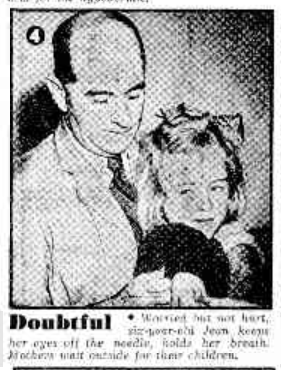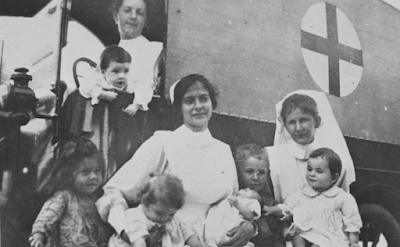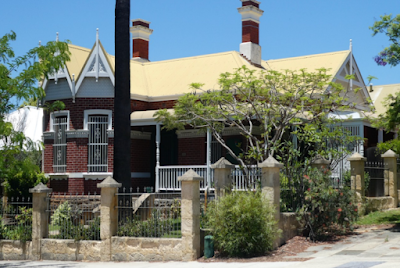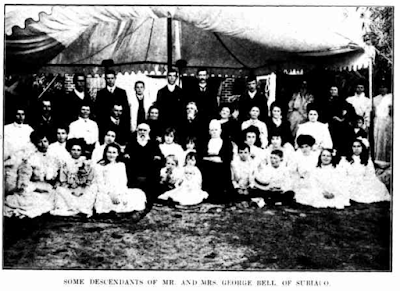Before COVID-19 - Germs Which Could Destroy Perth's Population...(1935).
Researching and writing about the history of disease in the early years of the colony, the prevention methods, the attitudes of people and health professionals towards vaccination and the survivor stories has been interesting.
In 1935, over 80 years ago, the Sunday Times published an article 'Germs Which Could Destroy Perth's Population' about diseases that could ravage Perth if not kept in check and easily wipe out over 207 000 people living in metropolitan area. The Pneumonic 'Flu was the worst fear along with cholera, cerebral spinal meningitis, bubonic plague, typhus, smallpox, scarlet fever, tuberculosis, diphtheria, whooping cough, polio, measles and tetanus.
A lot credit to constraining outbreaks of diseases went to Perth's geographical position and the work of the Health Department "...To its situation in the temperate zone, Perth owes much of its freedom from the outbreak of ghastly epidemics. The advance in medical science, and the efficiency of the Health Department are other factors in neutralising the potential deadly powers of these germs..." (Sunday Times, 25 August, 1935). Those reasons for the lack of spread of disease today continue.
As a child growing up in Perth I remember being vaccinated against several diseases including diphtheria, tetanus, measles, mumps, polio and rubella.
The second article is from the Daily News in 1947 which shows the reaction of Perth children being vaccinated against diphtheria in a city of Perth run clinic. Most of the stress for children involving vaccination, argued the doctor was the children being separated from their mother rather than the impact of the needle. Later the policy changed to include mothers being with their children while being vaccinated.
The articles are from Trove, the database of the National Library of Australia. No copyright infringement intended.
Sunday Times, 25 August 1935.
Germs Which Could Destroy Perth's Population
TINY ORGANISMS, BUT VIRULENT IN THEIR POWER
Pneumonic 'Flu is Our Worst Fear
SOME WORLD EPIDEMICS RECALLED
In Perth, at this minute, there are little organisms fake dots and dashes in appearance, which, if not kept in check, could wipe out nine-tenths of the 207,000 persons living in the metropolitan area!
Yet they are so small that only a microscope will reveal the largest of them.
The size and nature of the others cannot even be guessed. They are too tiny for the lenses to detect.
What epidemics could reasonably be expected to ravage Perth?
Of them all - plague, cholera, fevers - the pneumonic 'flu always threatens to be the worst
If you look through a high-powered microscope at fluids, food and, in fact anything exposed, to the air, you'll see that the objects being studied them with life.
Myriads of tiny blob and blotches can be distinguished through the magnifying lenses. And these odd-shaped organisms pulsate with life in their own fashion, as do the higher species of the animal kingdom, not even excluding man. They are called bacteria, or more commonly, germs.
Fortunately, in some instances, unfortunately in many others, these germs are either useful or harmful to man. Your microscope might reveal a type which to a large extent is responsible for butter having a flavor. Or perhaps it will show the
LITTLE ORGANISM
which obtains nitrogen from the atmosphere and supply it to certain growing plants. But, if it should show a little fellow which looks for all the world like two beans facing one another, fling, the stuff you're examining under the lenses as far as you can!
For those bean-like organisms are the germs which spread cerebra spinal meningitis.
This dread disease could quite possibly break out in Perth. It has done so in the past. The last epidemic here occurred in 1914, about the time of the beginning of the war, and a
INFLUENZA GERMS.
(These are magnified 1000 times.)
new chapter in our local medical history was written then. As a result of that visitation, many of the victims perished.
Another virulent germ with its, whose numbers may suddenly multiply so as to constitute a
MENACE TO THE LIFE
and health of the community, is the root and cause of pneumonic 'flu. In 1919 in Western Australia when this epidemic raged, many sufferers were stricken down. And such is the frightful potency of this germ that the 'flu will spread not only in cities, and not only in countries, but right throughout the world.
Seen under a microscope, too, the pneumonia germ looks its part. It has none of the innocent characteristics of the bean-like cerebral spinal meningitis germ, but is shaped like a spearhead I
Gaze as long as you will through the microscope at the conglomeration of dots and tails which work good and ill for man you will never discover the little fellow that is liable to slay little babies in their cradles. The demon of infantile paralysis parents and doctors shudder at the mere contemplation of this fiend breaking loose in Perth has never been with certainty recognised under the most powerful lenses.
For the scientist who eventually tracks down this germ await honor and renown perhaps the equal of Pasteur, Lister and other great research workers.
In the meantime medicine can only
BUBONIC PLAGUE GERMS.
call up all its resources to keep the demon on subjection.
Now leave your microscope for a minute and think of lice and the terrifying spectre that sometimes accompanies them, even in Perth ! The terror that is known as Typhus!
Typhus is spread from person to person by the medium of the bod}" louse, which bites an infected person and carried the virus to Its next human habitation and Typhus begins its grim campaign on mankind. Most fortunately Perth has managed to avoid a
SERIOUS OUTBREAK
of this agent of destruction. But it is not so many years ago that isolated cases of Brill's Disease were reported and Brill's Disease is a type of typhus although here the rat flea and not the louse is responsible for spreading the disease from rats to humans.
From smallpox now Perth should have little to fear, though a very small outbreak a few years ago did cause great alarm and consternation. Small-pox was a destroyer for centuries Queen Anne contracted it, with fatal consequences but the germ has never been discovered. Edward Jenner's success with vaccination during the 18th century has counteracted its virulence.
If vaccination became more general here, the danger of smallpox would practically disappear.
The dark races, however, are still subject to it, and in China, India and Central Asia, smallpox continues to take heavy toll of the native populace.
To its situation in the temperate zone, Perth owes much of its freedom from the outbreak of ghastly epidemics. The advance in medical science, and the efficiency of the Health Department are other factors in neutralising the potential deadly powers of these germs. But there remain other germs, sometimes to be seen under a microscope here, which commit, or have committed
UNSPEAKABLE RAVAGES
In other countries under the microscope, for instance, perhaps you might see a funny little "wog" just like a comma in shape. That will be the scourge of mankind, one of the worst plagues that have swept away White and Black alike.
For that twisted germ is CHOLERA. Cholera can wipe out a city, it can do more. Less than 100 years ago it threatened to destroy the very population of Europe.
The scourge made its first appearance in Bundelkhand (India) in 1817 when 500 persons died in five days. Within the next six years it ravaged India and Asia and slew incalculable thousands. Travelling via Central Asia, it smote Russia and with
FRIGHTFUL VIRULENCE
swept through Western Europe and America. Men literally died like flies.
Since then there have been other outbreaks of the dread disease in Europe. In 1848 cholera again ravaged England, and the known deaths exceeded 50,000. France and Spain reeled under several visitations before a particularly severe epidemic decimated the population of famine-stricken districts of Russia in 1892. In that riot of death 220,000 victims perished.
Cholera showed no mercy, and was no respecter of persons. In its wake stalked two other grim figures - Violence and Fear.
The scourge struck swiftly, relentlessly. And awful episodes bore witness to the startling rapidity of the infection. Contemporary writers have rendered horrible and ghastly accountsof mob scenes when the population of Paris took a panic at this visible evidence of the power of Death. "All pity was choken with custom of fell deeds." Eugene Sue, in "The Wandering Jew." describes
Two men carrying a stretcher covered with a blood-stained sheet; one of them suddenly felt himself attacked with the complaint; he stopped short, his powerless arms let go the stretcher; he turned pale, staggered, fell upon the patient, becoming as livid as him; the other man, struck with terror, fled precipitately, leaving his companion and the dying man in the midst of the crowd. Some drew back In horror; others burst into a savage laugh. The stretcher was over-turned, the old man and his companion were trodden underfoot, and their groan were drowned ... in yells of fury.
Truly an awful experience indeed! That our country has never known cholera's ravages is an act of Divine mercy for which we should be sincerely thankful!
Cholera made more gaps in the Allies' forces in the Crimea than, the Cossacks' swords and shells. In the South African war typhoid killed more than the bullets of the Boers. lt it
CHOLERA GERMS.
were not for the vigilance of our health authorities, Perth might easily suffer the ravages of a typhoid epidemic. For
BAD SANITATION
lies at the root of this scourge. Fingers, flies, food and filth! They are the four "f's" that lead armies and cities into the typhoid trap.
One other terrible scourge could overtake us. That is the bubonic plague. Mere mention of its name has caused people to tremble from one age to another.
The Black Death which reduced England's population from eight millions to four millions in the 14th century has been laid by some authorities at the door of the bubonic germ.
Three hundred years afterwards the germ returned and the plague slew Englishmen in their thousands. It was the Great Fire of London in 1866, which consumed the filth and squalor and crowded dwellings in which the germ bred and multiplied, that eventually checked its spread.
If you take your microscope, perhaps you'll see the bubonic germ. Like a tiny rectangle, or rod, it is, and rat fleas transmit it to man.
Dysentery, scarlet fever, measles any one of these may breakout in virulent form in Perth, though the precautions taken by the health authorities make epidemics highly improbable.
Of late there has been a
MEASLES EPIDEMIC,
though we look upon measles as a natural complaint which comes to practically every growing child. Generation after generation suffering from measles has rendered mankind less liable to be vulnerable to it. But it is the white man's disease, and an outbreak, say, of scarlet fever among a dark race will leave a trail of death. To measles, in part, is due the disappearance of the Red Indian In North America.
And how can these tiny organisms, smaller by far than a speck of dust, mark down humans and slay them in droves?
Once an organism gains entrance to the body, it produces disease by means of poisons called toxins which it discharges. So small, these germs are and yet so virulent.
The discovery that germs produce disease marks an epoch in medicine in the last one hundred years. Let long beforehand the knowledge that germs and disease stalked hand in hand had been suspected. As far back as 1680 the Dutch scientist Lowenhoek invented microscopic lenses. And by means of their immense powers of magnification he saw in saliva and other fluids little dots which represented living organisms.
Too small for the naked eye to see, they were, he considered, the root of diseases, but his observations were neglected and forgotten.
In the middle of the 19th century came the celebrated French chemist, Louis Pasteur, whose name will be always venerated as first among the pioneers to investigate this branch of science.
The late Lord Lister carried on where Pasteur left off. A surgeon working in Glasgow and then in Edinburgh, he proceeded to apply in practice the idea of the
GERM ORIGIN
of disease. He endeavoured to protect wounds from contamination with air, and to destroy germs in poisoned wounds by the use of chemicals. In this fashion he introduced the modern antiseptic surgical methods.
During the 19th century the researches of an obscure German doctor in a remote village aroused the attention of the medical world. So remarkable were his results in the study of germs that he was presently summoned to Berlin to continue with, and expand the scope of, his analyses. The outcome exceeded the
WILDEST EXPECTATIONS.
In March, 1882, Koch announced the discovery of the organism which causes tuberculosis. A year after this he isolated the cholera germ and thereafter in rapid succession the germs of typhoid fever, diphtheria and tetanus.
Thanks to his researches, and to others which followed in their train, cholera, tetanus, typhoid, diphtheria and the like are no longer the enemies of civilisation and the destroyers of whole nations.
Daily News, 19 July 1947.
Pictureport.
A Needle Saves Many Lives.
An old by building in Beaufort Street is the home of one of Perth's most important sickness prevention organisations - the Perth City Council's diphtheria immunisation clinic.
Twice a week, medical officers from the City of Perth Dr. A. P, Davis attends the clinic to give immunisation injections to for between 90 and 100 children.
He injects several hundred a year. In a course of four injections which ensure complete protection against disease which in the past has claimed hundreds of victims, many of whom died
Children from eight months are treated. Before the children are given the anti-diphtheria serum they are given a preliminary injection. According to the reaction in 24 hours Dr. Davis can tell whether they will prove sensitive to the anti diphtheria serum, if this is the case the children are still to be immunised, but with a smaller dose.
Says Dr Davis; 'You get some howls when you have the ones who have been here before so they know what happens. But temporary separation from their mothers is the thing that makes them cry, seldom the slight prick of the needle."




















